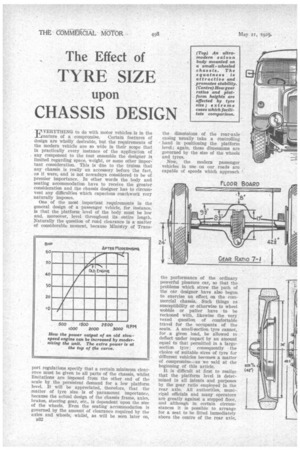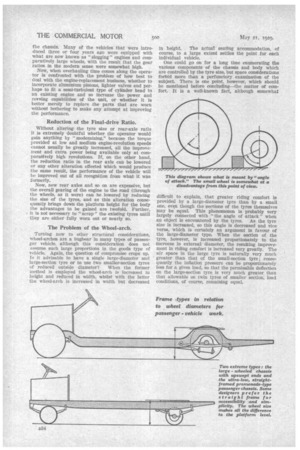The Effect of
Page 58

Page 59

Page 60

If you've noticed an error in this article please click here to report it so we can fix it.
TYRE SIZE
upon
CHASSIS DESIGN
IT
JERYTHING to do with motor vehicles is in the 11 nature of a compromise. Certain features of design are wholly desirable, but the requirements of the modern vehicle are so wide in their scope that in practically every instance of the application of any component to the tout ensemble the designer is limited regarding space, weight, or some other important consideration. This is due to the truism that any chassis is really an accessory before the fact, as it were, and is not nowadays considered to be of premier importance. In other words the body and seating accommodation have to receive the greater consideration and the chassis designer has to circumvent any difficulties which capacious coachwork very naturally imposes.
One of the most important requirements in the general design of a passenger vehicle, for instance, is that the platform level of the body must be low and, moreover, level throughout its entire length. Naturally the question of road clearance is a matter of considerable moment, because Ministry of Trans
port regulations specify that a certain minimum clearance must be given to all parts of the chassis, whilst limitations are imposed from the other end of the scale by the persistent demand for a low platform level. It will be appreciated, therefore, that the matter of tyre size is of paramount importance, because the actual design of the chassis frame, axles, brakes, steering gear, etc., is dependent upon the size of the wheels. Even the seating accommodation is governed by the amount of clearance required by the axles and wheels, whilst, as will be seen later on, B32 the dimensions of the rear-axle casing usually take a controlling hand in positioning the platform level; again, these dimensions are governed by the size of the wheels and tyres.
Now, the modern passenger vehicles in use on our roads are capable of speeds which approach the performance of the ordinary powerful pleasure car, so that the problems which strew the path of the car designer have also begun to exercise an effect on the commercial chassis. Such things as susceptibility or otherwise to wheel wobble or patter have to be reckoned with, likewise the very vexed question of comfortable travel for the occupants of the seats. A small-section tyre cannot, for a given load, be allowed to deflect under impact by an amount equal to that permitted in a largesection tyre; consequently the choice of suitable sizes of tyre for different vehicles become S a matter of compromise—as we said at the beginning of this article.
It is difficult at first to realize that the platform level is determined to all intents and purposes by the gear ratio employed in the rear axle. All authorities, municipal officials and many operators are greatly against a stepped floor, and although in certain circumstances it is possible to arrange for a seat to be fitted immediately above the centre of the rear axle,
it is not always convenient so to do, with the result that this part of the axle (where the casing is largest in diameter) forms the highest point in that section of the chassis devoted to body space after sufficient clearance has been allowed for it (the axle) to move up and down on its springs.
Now, the size of the "axle-pot," as it is called, is of course, dependent upon the diameter of the gear which is housed within it and as these sizes are dependent upon the diameter of the tyres, the gear ratio employed actually becomes of • first-rate importance. It will, of course, be understood that the diameter of a worm, for instance, is more or less a fixed quantity, because the wearing capacity assumes rather greater importance than the actual strength of the worm teeth, and although the torque in the axle shafts varies according to the reduction ratio, the actual dimensions of the worm itself are not materially affected— at any rate, in so far as Current practice is concerned with vehicles of _similar type. All this, however, merely takes effect upon the underside of the axle easing and has to do with road clearance ouly (assuming that underslung wormgearing is the general order), but on the upper side of the casing the diameter of the worm wheel definitely takes a controlling hand.
• As a case in point; let us compare a vehicle equipped with 44-in. by 10-in, giant tyres (the outside diameter of such a tyre is approximately 48 ins.) with a similar type of vehicle equipped with 32-in. by 6-in, pneumatic tyres.
If the vehicle with the 44-in. tyres be geared at 7 to I, the rear-axle reduction ratio of the other vehicle should only be in the order of 4.7 to 1, and the actual casing diameter would vary in something like the same proportion. Again, the difference in height of the centres of the axles would favour the small-diameter tyre by about 7 ins., so that the platform height immediately above the casing benefits accordingly by an amount considerably in excess of the variation in the centres. This characteristic is shown diagrammatically in two accompanying drawings.
One is tempted now to ask why tyres generally are not made much smaller than they are and where the matter of compromise enters the question. When considering any problem of this kind it is always advisable to take things to absurdities in order to see them clearly in their proper perspective. Imagine one vehicle, for instance, equipped with absurdly large wheels—;-10 ft. in diameter—and another one with absurdly small onec 6 ins, in diameter. The former would, seemingly, last for ever, whilst the latter would unquestionably wear out extremely qui kly, the actual length of tread in one case being ovet 31 ft. and in the other only slightly more than 14 ft. The pad t impress of the tyre upon the road, t , would have a great effect upon the life of the sin 11 tyre, owing to the great angular movement per nit length of road surface traversed.
There is another aspect of the case which, when considered from the operator's point of view, might prove interesting. We refer to the effect of modern ideas in engine design upon the layout for the rest of the chassis. Many of the vehicles that were introduced three or four years ago were equipped with what are now known as "slogging" engines and comparatively large wheels, with the result that the gear ratios in the modern sense were somewhat high.
Now, when overhauling time comes along the operator is confronted with the problem of how best to deal with the engine-replacement business, whether to incorporate aluminium pistons, lighter valves and perhaps to fit a semi-turbulent type of cylinder head to an existing engine and so increase the power and revving capabilities of the unit, or whether it is better merely to replace the parts that are worn without bothering to make any attempt at improving the performance.
Reduction of the Final-drive Ratio.
Without alteringthe tyre size or rear-axle ratio it is extremely doubtful whether the operator would gain anything by "modernizing," because the torque provided at low and medium engine-revolution speeds cannot usually be greatly increased, all the improvewent and extra power being available only at comparatively high revolutions. If, on the other hand, the reduction ratio in the rear axle can be lowered or any other alteration effected which would produce the same result, the performance of the vehicle will be improved out of all recognition frOm what it was formerly.
Now, new rear axles and so on are expensive, but the overall gearing of the engine to the road (through the wheels, as it were) can be lowered by reducing the size of the tyres, and as this alteration consequently brings down the platform height for the body the advantages to he gained are twofold. Further, it is not necessary to "scrap" the existing tyres until they are either fully worn out or nearly so.
The Problem of the Wheel-arch.
Turning now to other structural considerations, wheel-arches are a bugbear in many types of passenger vehicle, although this consideration does not assume such large proportions in the goods type of vehicle. Again, the question of compromise crops up. Is it 'advisable to have a single large-diameter and large-section tyre or to use two smaller-section tyres of reduced outside diameter? When the former method is employed the wheel-arch is increased in height and reduced in width, whilst with the latter
• the wheel-arch is increased in width but decreased In height. The actual seating accommodation, of course, to a large extent settles the point for each individual vehicle.
One could go on for a long time enumerating the various components of the chassis and body which are controlled by the tyre size, but space considerations forbid more than a perfunctory examination of the subject. There is one point, however, which should be mentioned before concluding—the matter of comfort. It is a well-known fact, although somewhat difficult to explain, that greater riding comfort is provided by a large-diameter tyre than by a small one, even though the isections of the tyres themselves may be equal. This phenomenon is probably very largely connected with "the angle of attack" when an object is encountered by the tyres. As the tyre size is increased, so this angle is decreased and vice versa, which is certainly an argument in favour of the large-diameter type. When the section of the tyre, however, is increased proportionately to the increase in externaldiameter, the resulting improvement in riding comfort is increased very greatly. The air space in the large tyre is naturally very much greater than that of the small-section tyre; consequently the inflation pressure can be proportionately less for a given load, so that the permissible deflection on the large-section tyre is very much greater than that allowable on twin tyres of smaller section, load conditions, of course, remaining equal.




















































































































